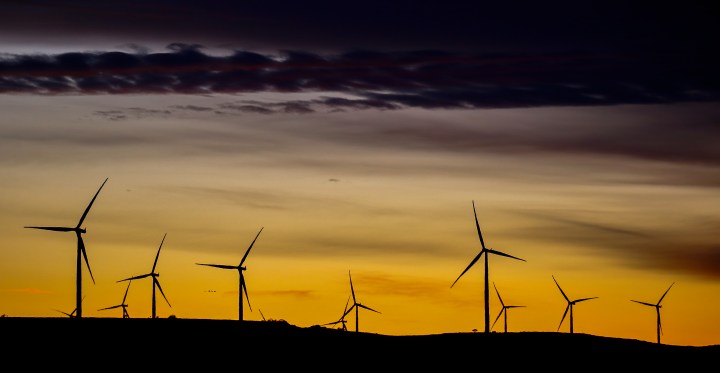POWER CRISIS
An effective roll-out of renewable energy could have prevented 2021 load shedding and saved billions – report

A new report released by Meridian Economics has found the power cuts could have been avoided if the grid had an additional 5,000MW or 5GW of generation capacity.
Last year saw the worst record of load shedding implemented by Eskom, with people in South Africa spending over 1,165 hours without power.
Now, a new report by Meridian Economics released this week has found the power cuts could have been avoided if the grid had an additional 5,000MW or 5GW of generation capacity.
Beyond load shedding and its impacts, the authors of the report also say that Eskom could have saved R2.5-billion and spared 13.6 metric tonnes of carbon dioxide equivalent (Mt CO2-eq) being released into the atmosphere.
The news follows the signing of the first three “landmark” power purchase agreements (PPAs) under the Risk Mitigation Independent Power Producer Procurement Programme (RMI4P), and Minister of Mineral Resources and Energy Gwede Mantashe’s announced intention to revise the Integrated Resource Plan (IRP2019).
Our Burning Planet reported that Norwegian renewable energy company Scatec entered into a 20-year agreement with Eskom to dispatch 150 MW to the national grid, between 5am and 9.30pm daily.
Meridian’s report – Resolving the power crisis Part A: Insights from 2021 – SA’s worst load shedding year so far – ventilates considerations with far reaching implications for South Africa’s nascent energy transition and broader Paris-aligned decarbonisation agenda.
The authors explain that they used Eskom’s actual data to “investigate the impact that additional generation capacity would have had on load shedding if it had been operational last year”. They add that they were focussing on the shortest lead-time and cheapest sources of power generation – wind and solar.
Read in Daily Maverick: https://www.dailymaverick.co.za/article/2022-06-03-landmark-power-purchase-agreements-signed-but-mantashe-still-punts-multiple-energy-technologies/
According to the authors of the study, their modelling found that “an additional 5 GW of wind and solar (the approximate capacity of two REIPPPP bidding rounds) in the same proportion as the currently installed capacity, would have allowed Eskom to eliminate 96.5% of load shedding in 2021.”
Moreover, the additional wind and solar capacity would have reduced the amount of diesel burnt in the open cycle gas turbine (OCGT) “peakers” by more than 70%, simply by generating power at the time that these were running, the authors state.
Eskom explains that “peaking means we can react quickly to changes in demand and provide power to supplement that generated by base-load stations, which are coal and nuclear”.
Meridian’s report says that “more optimal use of Eskom’s pumped storage assets, enabled by the additional energy on the system, could have created further diesel savings – exceeding 80% in all”.
A recent News24 article noted that the expenditure on these OCGT amounted to R6.4-billion for the year ended March 2022, while in the previous financial year, this figure was R4.1-billion.
Given the current global situation, Eskom expects spending on diesel to exceed R15-billion in the current financial year, adding yet greater urgency to the need to add additional, renewable generation capacity.
André de Ruyter, Eskom’s CEO, has been at pains to repeat that the most direct way to end load shedding in the shortest time would be to rapidly address the generation capacity shortfall.
The outcome of the Meridian study confirms this.
The authors of the Meridian report also analysed the cost impact of adding 5 GW of renewable energy capacity.
“Based on Eskom’s 2020/21 financial year dispatch cost of OCGTs (R3.04/kWh) and coal power (R0.42/kWh), and assuming renewables prices around R0.68/kWh, the additional 5GW of wind and solar would have created a net annual saving of R2.5-billion for Eskom,” they write.
“This takes no account of the economic benefit of avoiding load shedding but is merely the net cash saving to Eskom driven primarily by reduction in the quantity of diesel burned.”
Meridian’s report also provides insight into how the addition of this renewable energy generating capacity might have had an impact on South Africa’s greenhouse gas emissions.
“Adding 5GW of renewables with the support of demand response and batteries would not only put paid to load shedding, save significant sums of money, but also have a material impact on Eskom’s annual emissions.
“This is primarily due to the resultant reduction in coal burn required, as well as the reduced emissions from lower utilisation of the OCGT and associated diesel burn.”
They explain that there would be 13.6 metric tonnes annual saving in carbon dioxide equivalent (Mt CO2-eq).
“Eskom’s emissions for FY21 were 206.8 Mt – the saving would thus result in an approximate 6.6% decrease in this figure,” says Meridian.
South Africa’s carbon emission targets – or Nationally Determined Contributions – range between 350 and 420 metric tonnes of carbon dioxide equivalent (Mt CO2-eq).
Seen in this context, rapidly adding renewable energy generation capacity would not only have prevented the majority of load shedding in 2021, but also bolstered South Africa’s attempts at helping to limit global warming to 1.5°C over pre-industrial era global average temperatures.
These numbers are important in the context of the Paris Agreement, wherein 197 countries agreed to limit global warming to well below 2°C and make efforts to limit it to 1.5°C. These temperatures represent the thresholds beyond which the world can begin to expect the worst impacts of “dangerous climate change”.
A study in the journal Nature Climate Change explains that “meeting the 1.5°C goal with 50% probability translates into a remaining carbon budget of 400-800 Gt CO2. Staying within this carbon budget requires CO2 emissions to peak before 2030 and fall to net zero by around 2050”.
Put simply, South Africa should ideally only emit 350 Mt CO2-eq as its fair portion of the roughly 400-800 billion tonnes of carbon dioxide equivalent the world can still absorb before humans finish making this planet less conducive to life as we’ve known it.
The new report is especially illuminating when read in conjunction with a consultation paper published in late May and developed by Blended Finance Taskforce and the Centre for Sustainability Transitions at Stellenbosch University, called, “Making Climate Capital work: Unlocking $8.5bn for South Africa’s Just Energy Transition”.
The authors of the paper explain that South Africa’s beleaguered energy system offers both an opportunity to reduce greenhouse gas emissions, spur on green growth and end the national bane that is load shedding.
However, it all depends on whether the right things are done with the requisite urgency.
“To guarantee energy security and affordability, South Africa is looking to its vast solar, wind and mineral resources. The cost of building new wind and solar capacity in South Africa is already 40% cheaper than new coal, based on the levelised cost of energy, promising new investment and job opportunities under an accelerated transition to a low carbon energy system,” they write.
They add that “the recently approved National Infrastructure Plan adheres to a ‘least-cost’ pathway, aiming to reduce emissions from ~200 Mt a year today to ~50 Mt in 2050.
This plan represents cumulative emissions of 3.9 Gt from the power sector in South Africa through to 2050. However, to meet climate goals, these cumulative emissions must be at least 1 Gt lower (cumulatively 2.8-3.0 Gt or less).
These plans are not without obstacles, including the need for climate financing on a scale that eclipses the sovereign’s domestic capacity.
Read in Daily Maverick: Climate finance for African Nations is the sustainable solution – activist and author Vanessa Nakate
Should South Africa accelerate its planned decommissioning of coal-fired power plants, the country’s power sector could “avoid an additional 1.4 Gt of carbon emissions against the least-cost reference case.
“This would require coal to come offline faster than currently scheduled (i.e. by 2040), with investments and costs coming to over $250bn over the next three decades,” write the authors of the Making Climate Capital Work paper.
They say that under an ambitious scenario, South Africa could install around 5 GW a year of renewable energy capacity out to 2050, and that half of the country’s generation needs should be met by renewables by the end of the decade.
Put differently, South Africa would need roughly R4-trillion in investments over three decades to ensure a just energy transition and a resilient, reliable supply of electricity that does not complicate efforts to limit global warming.
Referring to the $8.5bn commitment pledged by developed countries at COP26 to aid South Africa’s just energy transition, the authors explain that this represents roughly 3% of what is actually needed to “deliver an ambitious energy transition in South Africa”.
“At its best, the $8.5bn commitment can create a blueprint for what ‘good’ looks like – a transparent deal that provides the type of capital needed to tackle the key transition challenges of decommissioning coal while supporting communities and spurring green growth,” write the authors.
“At its worst, this will be another announcement without impact – another nail in the coffin for the social compact between rich countries and the rest of the world.
“And a confirmation that the development finance system cannot – or will not – respond to the needs of climate-vulnerable countries, including those with ambitious plans to transition.” OBP/DM
This story first appeared in our weekly Daily Maverick 168 newspaper, which is available countrywide for R25.






















 Become an Insider
Become an Insider
Comments - Please login in order to comment.